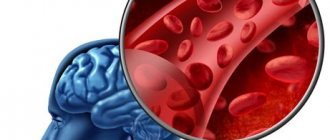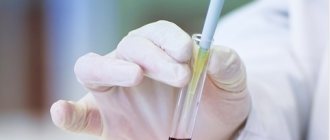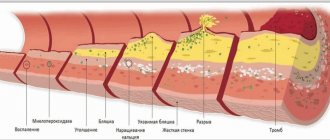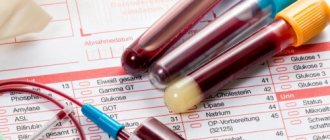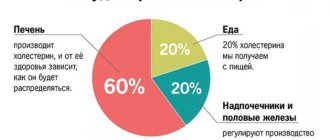Biochemical blood test A biochemical general therapeutic blood test is one of the most common tests used to assess health status. Cost of analysis
Comprehensive examination Using a biochemical general therapeutic blood test, you can check indicators such as glucose, total protein, cholesterol, ALT, AST, calcium and others. More details
Preventive examination Regular checks of biochemical parameters of the body help to identify various diseases in a timely manner. Where can I get tested?
Prevention of diseases Some diseases are asymptomatic and can only be detected through laboratory tests. Where can I get tested?
Tests at home You can take the necessary tests without leaving your home. Call a specialist to your home
Promotions and special offers Special offers and discounts on diagnostic laboratory services allow you to save on medical examinations. View current promotions
A complete blood count is one of the most common and most necessary diagnostic tests[1]. It allows the doctor to assess the patient’s blood parameters and quickly draw initial conclusions about the state of his health.
When is a general blood test prescribed?
Human blood consists of hundreds of components. For each of them there are certain standards, and it is the general analysis that allows for a basic study of the main blood parameters. The study is carried out for:
- primary diagnosis of a number of diseases (infectious diseases, anemia, malignant neoplasms and other pathologies);
- assessing the effectiveness of treatment;
- general assessment of a person's health status.
A general blood test involves a comprehensive assessment of the patient’s condition, which makes it possible to identify signs of a particular disease or pathological process. The analysis is prescribed to almost all patients who seek specialized medical care. Taking blood from a vein to conduct a general blood test is a fairly simple, but at the same time informative analysis for the doctor. For example, it allows one to suspect that a patient has allergic or infectious diseases. However, it should be remembered that a general blood test alone is not enough to make a final diagnosis, and the doctor may also prescribe other tests. Thus, a general blood test helps the doctor set a narrower direction for a detailed diagnosis.
This is interesting
Human blood is constantly renewed. Every hour in an adult, approximately five billion white blood cells, two billion platelets and one billion red blood cells are destroyed. They are replaced by new, young cells. About 25 grams of blood are completely renewed per day[2].
Decoding the general blood test of adults: norm and pathology
Like most diagnostic tests, a complete blood count is performed in the morning and on an empty stomach. The result - a summary table of indicators - can be available either the same or the next day. What does a general blood test include?
Here are the most common general blood test indicators examined in a clinical laboratory:
- hemoglobin;
- red blood cell count;
- color index;
- reticulocyte count;
- platelet count;
- ESR;
- leukocyte formula;
- hematocrit;
and so on.
Let us consider these indicators and their norms in the blood of a healthy person in more detail. Let's start with hemoglobin (Hb) - one of the most important components of red blood cells [3]. If hemoglobin is reduced, this may indicate a lack of iron [4] (it is used in the process of hemoglobin synthesis) or vitamin B12 in the body, and be the first sign of developing anemia. A significant (several times) increase in hemoglobin may indicate that the patient has pulmonary or heart failure. Increased hemoglobin can also be observed in cases of oncological diseases and kidney pathology, but not a single highly qualified doctor, as mentioned above, will make a final diagnosis based on a general blood test alone, therefore, even if hemoglobin in the blood is greatly increased, There is no need to panic in advance. The norms for this indicator for adults approximately look like this: 131–173 g/l for men 18–64 years old and 117–160 g/l for women of the same age.
Red blood cells (RBCs) are transport cells. They deliver oxygen to all tissues and organs and take away carbon dioxide.
The average normal erythrocyte count for adult men 18–64 years old is considered to be 4.2–5.7 × 1012/L, and for women – 3.8–5.3 × 1012/L. A reduced number of red blood cells may indicate anemia as a result of a deficiency in the body of iron, vitamin B12 or blood loss - for example, with heavy menstruation in women, hidden bleeding. An increased number of red blood cells occurs in people who have been high in the mountains for some time, where the air is thin. Such a change is adaptive in nature and is the norm. Also, increased concentrations of red blood cells may indicate to the doctor that the patient has problems with the hematopoietic, respiratory or cardiovascular system. That is why it is very important, after receiving test results, not to self-medicate under any circumstances. You need to contact a specialist.
Reticulocytes (RTC) are young cells that perform the function of a “blank” for older cells[5]. By the speed with which they appear in the bloodstream, the doctor can judge the functioning of the bone marrow, kidneys, as well as the patient’s blood itself. Normally, in adult men the rate is 0.2–1.92%, in women – 0.2–2.07%. Elevated reticulocytes can be either normal or a deviation from it. So, for example, if a patient has recently lost a lot of blood and reticulocytes are elevated, this is normal. If there was no blood loss, an increased percentage of reticulocytes may indicate the presence of diseases such as hemolytic anemia or malaria [6]. In patients with cancer, an increase in reticulocytes may indicate metastases to the bone marrow. A decrease in level is a signal that the kidneys or bone marrow are affected, or that these organs are depleted due to prolonged erythropoiesis. This may also indicate metastases in the bone marrow: unfortunately, it is impossible to predict which part of the bone marrow the tumor will metastasize to and how this will affect reticulocytes - in the direction of reducing or, conversely, increasing cell growth.
ESR (ESR) is the erythrocyte sedimentation rate . In women under 50 years of age, the rate should not exceed 20 mm/hour, in older women - 30 mm/hour. For men under 50 years of age, the norm is 15 mm/hour, and after 50—20 mm/hour. If the ESR is elevated, this may indicate the presence of an inflammatory process in the body, poisoning, anemia, or large blood loss.
The color index (average erythrocyte hemoglobin concentration) (MCHC) of blood indicates how saturated the red blood cells are with hemoglobin. Normally it will look like this: from 300 to 380 g/l. A decrease indicates possible thalassemia or iron deficiency; an increased rate may indicate a deficiency of vitamin B12 and folic acid in the body.
The main function of platelets (PLT) is to stop bleeding by forming a blood clot[7]. The normal platelet level is 180–320 × 109/L. An increase in the platelet count may indicate to the doctor the presence of injury, possibly a malignant tumor, an infectious process, or some other diseases. Thrombocytosis may be temporary and disappear when the condition returns to normal - for example, if a person has recently undergone surgery. Low platelets often indicate poisoning of the body with chemicals, the presence of an infectious disease, an autoimmune process, deficiency of vitamin B12 and folic acid, leukemia in acute or chronic form. The result of platelet levels in the blood is also affected by the use of certain medications, so it is very important to tell the doctor what medications the patient is currently taking to enable the specialist to formulate the correct diagnostic picture.
White blood cells (WBCs) in the body are responsible for immunity, and their numbers can indicate to the doctor that the body is in a state of fight against viruses, foreign bodies, pathogens or toxins. The normal white blood cell count may vary slightly depending on a person's age (see table below), but generally ranges from 4.5 to 11.3 x 109/L. A decrease in the indicator can be observed, for example, with blood diseases, viral infections, enlarged spleen and during chemotherapy. A high level may indicate the presence of a bacterial, fungal, viral infection in the body, acute bleeding, and so on.
Lymphocytes (LYM) are the main “building blocks” of the immune system. The normal level in the blood of an adult is 1.2–3.0 × 109/l. If the concentration is increased, wide-spectrum infectious diseases are usually diagnosed[8]. Low levels often indicate renal or immune failure, chronic diseases, and are also observed with long-term use of corticosteroids.
The leukocyte formula helps determine the presence of infectious diseases and oncological processes by the ratio of certain types of leukocytes to each other.
If neutrophils are higher than normal, which is 47–72% of the total number of particles of this class, this may indicate infectious diseases (sinusitis, sore throat, bronchitis, pneumonia, etc.), an inflammatory process (arthritis, pancreatitis, etc.), chronic metabolic disorders substances, heart attack or allows one to suspect the presence of a malignant neoplasm. With neutropenia - a low level of neutrophils - infectious diseases such as typhoid fever, influenza, brucellosis, measles, rubella and others may be present. This may also indicate recent treatment with radiotherapy or chemotherapy, or the use of antiviral drugs.
Eosinophils (EOS) are normally present in the blood in a ratio of 1–5% of the total number. If the indicator is higher, this can tell the doctor about the patient’s allergies, parasitic infestations, infectious diseases (scarlet fever, tuberculosis and others), malignant tumors, leukemia and other diseases of the hematopoietic system[9]. Eosinophils in the blood decrease with heavy metal poisoning, sepsis or the onset of an inflammatory process.
Basophils (BAS) are normally practically undetectable in the blood of a healthy person, as they make up up to 1% of the total number of cells. An increase in the formula may indicate the development of diseases such as nephrosis, hemolytic anemia, chicken pox, hypothyroidism, chronic myeloid leukemia, Hodgkin's disease, drug or food allergies, taking hormonal drugs, ulcerative colitis, or observed after removal of the spleen.
Monocytes (MON) are responsible for engulfing dead cells and bacteria. An increased level of monocytes indicates diseases such as rheumatoid arthritis, syphilis, mononucleosis, tuberculosis and other infectious diseases. A decrease is observed when taking corticosteroids or after major operations.
This is interesting
All parts of the human body are supplied with oxygen through the blood. The only exception is the cornea of the eye - it does not have blood vessels[10]. The cornea must be perfectly transparent, so oxygen dissolved in tears enters its cells directly from the air.
Table of normative (reference) indicators of clinical blood analysis of adult men and women
It is better, as mentioned above, to entrust the interpretation of the analysis indicators to a doctor, since the results may vary depending on the patient’s age, gender and other factors[11]. These reference values (normal limits) may also vary depending on the laboratory.
| Indicator name | Designation | Norm |
| Red blood cell count | R.B.C. | for men: 18–44 years old - 4.3–5.7 × 1012/l; 45–64 years old - 4.2–5.6 × 1012/l; from 65 years old - 3.8–5.8 × 1012/l |
| for women: 18–44 years old - 3.8–5.1 × 1012/l; 45–64 years old - 3.8–5.3 × 1012/l; from 65 years old - 3.8–5.2 × 1012/l | ||
| Hemoglobin | HGB, Hb | for men: 18–44 years old – 132–173 g/l; 45–64 years old – 131–172 g/l; from 65 years old - 126–174 g/l |
| for women: 18–44 years old - 117–155 g/l; 45–64 years old – 117–160 g/l; from 65 years old - 117–161 g/l | ||
| Hematocrit | HCT | for men: 18–44 years old – 39–49%; 45–64 years old – 39–50%; from 65 years old - 37–51% |
| for women: 18–44 years old - 35–45%; after 45 years - 35–47% | ||
| Platelet count | RLT | 180–320 × 109/l |
| White blood cell count | WBC | 4.5–11.3 × 109/l |
| Granulocyte count | GRA, GRAN | up to 0.09 × 109/l; or up to 0.6% |
| Monocyte count | MON | 0.09–0.60 × 109/l; or 3–11% |
| Lymphocyte content | LYM, LY% | 1.2–3.0 × 109/l; or 19–37% |
| Red blood cell distribution width | RDWc | 11,6–48,8 % |
| Average red blood cell volume | MCV | 80–100 fl |
| Average hemoglobin concentration in erythrocyte | MCHC | 300–380 g/l |
| Average hemoglobin content in an erythrocyte | MCH | 27–35 pg |
| ESR (erythrocyte sedimentation rate) | ESR | for men: 18–49 years old - up to 15 mm/h; after 50 years - up to 20 mm/h |
| for women: 18–49 years old - up to 20 mm/h; after 50 years - up to 30 mm/h |
Changes in each individual or several indicators of a general blood test may be characteristic of various diseases. In order to correctly “read” the results form, the doctor needs to know as much as possible about the patient: from symptoms and time of onset of illness to dietary supplements that he has recently consumed. You should definitely share this information with your doctor.
What can the results of the analysis indicate?
- A change in the level of leukocytes (increase/decrease) may indicate the development of infectious diseases or tumors of any location.
- A decrease in the number of red blood cells is observed with anemia, internal bleeding, and an increase with dehydration and cancer.
- Changes in platelet levels indicate bleeding disorders, autoimmune diseases, or bone marrow diseases.
- An increase in ESR by 3-5 times is a sign of an inflammatory process in the body.
- A decrease in hemoglobin levels can be caused by chronic blood loss (including erosive gastritis, stomach ulcers, hemorrhoids), pregnancy, vegetarianism, impaired absorption of iron in the intestines, and liver diseases.
- An increase in hemoglobin levels is typical for those who consume a lot of meat and little liquid. Hemoglobin above 160 g/l can also be a sign of chronic leukemia.
A detailed interpretation of the data should be carried out by a specialist, taking into account the gender, age and complaints of the patient.
At the Spectra clinic you can take a general blood test at a time convenient for you. Taking blood will take a few seconds, the results will be ready within 1-2 days. Experienced specialists will advise you on all questions that arise and, if necessary, help you select a set of further diagnostic measures.




